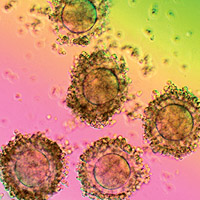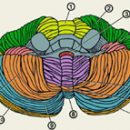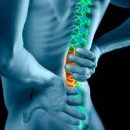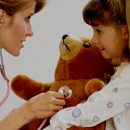Today is diagnosed «lateral amyotrophic sclerosis» It is equivalent to almost a sentence: only one case of stabilizing the state of the patient with this ailment. But hope is that someday this disease will become curable, there is. In the world of scientists, this hope is associated with stem cell research.
Content
Lateral amyotrophic sclerosis - a difficult disease and a little studied, despite the fact that numerous studies have been held for decades. A fairly effective method of treatment and not found. Some scientists believe that an important role in the restoration of damaged motor neurons or even in the creation of new, stem cells could be played with their ability to differentiate into a plurality of cell lines.
The side amyotrophic sclerosis, also known as the disease Lu Geriga, is a progressive disease, which is expressed in the gradual development and distribution of weakness and atrophy of the affected muscles of the patient. Such a state leads to muscle dysfunction, incapacity and ultimately to death or constant dependence on the auxiliary means of breathing, which comes on average 3 years after the weakness of the muscles is diagnosed.
Approximately 5% -10% people with lateral amyotrophic sclerosis have relatives with such a disease. Most cases of sides of lateral amyotrophic sclerosis (90% to 95%) have a sporadic nature, often arising «Completely unexpected», But there is a rare form of lateral amyotrophic sclerosis, which can be traced in 3 Western areas of the Pacific: Guam, Peninsula Ki in Japan and Western New Guinea. Many etiological factors are associated with the fact that the process of exhaustion remains incomprehensible and inexplicable.
Factors that run a chain of events leading to the death of motor neurons are unknown. It can be assumed that the changed gene leads to the development of a toxic substance, which launches the disease process. Even in 15% -20% of families who have mutted gene, the mechanism of its action, accelerating the beginning of the disease, remains unknown. We are also unknown the reasons for the occurrence of such a disease at different ages and the rate of its progression, associated with specific mutations of the gene, as well as the cause of incomplete morbidity (most of the carriers of the gene are affected, but not all).
And even less is aware of the causes of the disease in sporadic cases of the western region of the Pacific. Direct cause of muscle weakness and their exhaustion - progressive loss of muscle motor neurons. Nervous cells located in the spinal cord or in the brain trunk and directly related to the muscles (lower motor neurons), and in the cerebral cortex (upper motor neurons) associated with lower motor neurons. Nervous cells and chains that are in the front share of the brain can also be affected (despicable motor neurons).
No method of treatment can delay or draw the development of lateral amyotrophic sclerosis. There is a recommended method of treatment (with the help of riluzole), which can add 2-3 months to the average life expectancy of the patient with lateral amyotrophic sclerosis. Careful adherence to the diet and the timely use of non-invasive support for breathing can expand the temporary framework of the patient's life for another 6-12 months.
 Stem cells are cells that did not pass differentiation and did not acquire specific functions; They have the potential of self-healing, divide and differentiate into specific cell types. Differentiation of stem cells in adult cells is clearly adjusted; Otherwise, complex plants or animals could exist, with their many interrelated tissues and organs. In contrast to stem, mature or differentiated cells form specific structures and perform certain functions and in many cases lose the ability to share and multiply.
Stem cells are cells that did not pass differentiation and did not acquire specific functions; They have the potential of self-healing, divide and differentiate into specific cell types. Differentiation of stem cells in adult cells is clearly adjusted; Otherwise, complex plants or animals could exist, with their many interrelated tissues and organs. In contrast to stem, mature or differentiated cells form specific structures and perform certain functions and in many cases lose the ability to share and multiply.
Malignant or «Dedifferentiated» Cells differ from stem and normal specialized in that they are divided uncontrollably and carry the danger of the cultivation of the body. Differentiation of the stem cell should turn on, get the right direction and turn off so that the necessary fabrics are built in various organ systems. Stem cells, including nervous stem cells, by definition are present in embryos. Stem cells can be found in cord blood. In adults, these cells are in the bone marrow and other organs in which controlled self-healing is required.
The question of the ethicality of research on a person at an early stage of studies of stem cells, with an emphasis on the risks of premature clinical trials. Reports of transplantation of stem cells conducted in China without considering independent experts of objective data for each patient before, immediately after and after a long time after transplantation, do not provide the necessary scientific information to establish the safety and effectiveness of this method.
«It is critical that scientists and clinicians are careful, planning strictly scientific research, and especially need to focus on key laboratory experiments that can provide answers to many questions that are now facing this therapeutic method», - Written Lucy Brujahn, director of science and vice president of the Association «BASS» (lateral amyotrophic sclerosis). - «In order for such therapy to be safe and had the possibility of clinical use, it is necessary that the properties and complexity of various stem cells.» In response to the restriction of stem cell research, which can receive federal financing, the American Academy of Neurology and the American Neurology Association - two leading professional organizations of neurologists in the United States - expressed confidence that work with both embryonic and adult stem cells should carried out carefully and under strict control. Members of these organizations and the public are concerned about the observance of important ethical standards in the studies of embryonic stem cells.
There are two circle of scientific problems. First, due to the fact that the probability of success of a separate study is quite low, for further rapid development, parallel studies are needed in various directions. The essence of research - samples and errors that identify ineffective directions, thus allowing you to focus on more promising. Between the beginning of scientific research and clinical use of the method usually takes place.
Therefore, any delay in determining the therapeutic potential of the method leads to a delay in the introduction of this treatment method. Secondly, the elimination of certain types of research from federal financing can lead to the loss of such studies from the field of view of the state and loss of control over them, as well as to the transition of these studies in other countries. And this may cause damage to both specific patients and the entire community of patients, clinicians and scientists.
Studies of stem cells give hope to patients with lateral amyotrophic sclerosis and can lead to the development of new treatment methods that slow down the progress of the disease. But this hope should be combined with caution, since the study of stem cells is still at an early stage in general, and with the side amyotrophic sclerosis, in particular, as well as due to the limited efficiency of all pharmacological effects on transgenic mice and patients with neuribrous lateral amyotrophic sclerosis. In future studies of stem cells, clinicians, scientists, as well as patients who participate in them, should pay close attention to the issues of ethics and scientific rigor.









